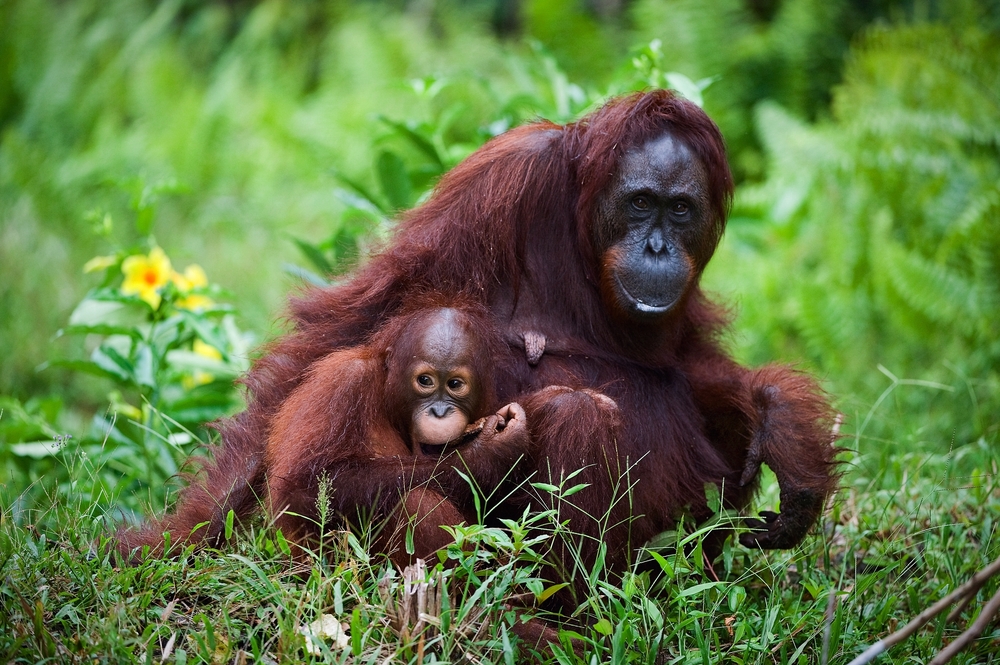
People and animals in Indonesia currently face an apocalyptic scenario. Wildfires are ploughing destructive paths through the nation’s islands, producing more carbon dioxide than the entire US economy while polluting the country in a thick and inescapable smog.
Similar fires take place every year, with dried-out peat forests intentionally burned to make room for industrial plantations. It’s always an ecological catastrophe, but this year’s extreme weather conditions mean that the blaze has spread farther than ever, leading to the worst wildfire in Indonesian history.
Things are awful for the choking human masses of Indonesia, but animals have it even worse—their only choice is to try to flee the chaos, destined to an untimely end whether or not they burn with the forests. Many of the animals under threat are endangered, some critically so. Here are a few species that desperately need saving.
Orangutan
Fires are ravaging Sabango Forest in Borneo, home to the world’s largest population of wild orangutans. These intelligent apes have long been symbols of conservation; they’re critically endangered due to their habitats being destroyed and turned into palm oil plantations. This year’s wildfires mean that a third of the planet’s remaining wild orangutans could be killed.
Sumatran tiger
Sumatran tigers are the only remaining subspecies of Sunda Island tiger. They already suffer extreme habitat loss—it’s estimated that there are fewer than 400 of these precious big cats left, and disasters like wildfires mean they could meet the same tragic fate as their extinct cousins, Javan and Balinese tigers.
Proboscis monkey
One of Indonesia’s most brilliantly bizarre species: proboscis monkeys have incredible noses that can exceed 10cm in length, sometimes hanging below their mouths. As they live among orangutans on the island of Borneo, they’re also in real danger from the fires.
Sumatran elephant
Although previously widespread on the island of Sumatra, populations of this Asian elephant subspecies have decreased by around 80 percent over the last 75 years, making them critically endangered. Habitat loss is one of the Sumatran elephant’s primary threats, with huge sections of the forests they call home going up in smoke. Their relatives, Borneo elephants, are similarly threatened by wildfires.
Sun bear
Habitat loss is one reason for the sun bear becoming a threatened species, but it’s by no means the only one. The majority of hazards faced by these magnificent creatures can be traced back to humans—they’re cruelly farmed for their bile, poached for their meat, and even sold as pets.
Helmeted hornbill
Few could deny the strange charm of the helmeted hornbill, one of Indonesia’s most recognisable wild birds. The species is classified as near threatened, mainly because it’s hunted for the unique red ivory found on its bill. Annual wildfires certainly don’t help, with populations in Borneo and Sumatra both severely affected by the loss of forests.
Sumatran rhinoceros
It used to be relatively easy to find these hairy rhinos throughout Southeast Asia; nowadays fewer than 100 are thought to remain in the wild. Poaching is a particular cause for concern, but the wildfires blazing through their homes are another unwelcome and potentially devastating threat.
Clouded leopard
These mesmerising creatures are considered an evolutionary link between big cats and small cats. Despite being some of the most talented climbers in the cat world (capable of running headfirst down trees and hanging from branches with their hind paws), their acrobatic skills sadly aren’t enough to help them escape from the type of large-scale deforestation that leads to forest fires in Indonesia every year.
Fancy helping to save some of these incredible animals? Consider donating to the World Resources Institute, which aims to curb deforestation and restore land that’s already been cleared, giving a better chance to wild species’ like the ones on this list.
